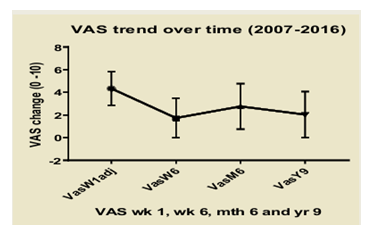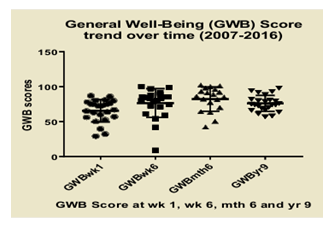Does Esoteric Connective Tissue Therapy ( ECTT) have Efficacy and Long Term Benefits Treating People with Chronic Musculoskeletal Pain
Kate Greenaway1*, Michelle Sheldrake2
1Self-employed Physiotherapist, NSW, Australia
2Independent Researcher, Brisbane, Australia
*Corresponding author: Kate Greenaway, Self-employed, Physiotherapist, Universal Medicine Clinic Goonellabah, NSW, Australia
Received: 22 December 2020; Accepted: 29 December 2020; Published: 01 January 2021
Article Information
Citation: Kate Greenaway, Michelle Sheldrake. Does Esoteric Connective Tissue Therapy ( ECTT) have Efficacy and Long Term Benefits Treating People with Chronic Musculoskeletal Pain. Archives of Physiotherapy and Rehabilitation 4 (2021): 001-004.
View / Download Pdf Share at FacebookAbstract
Background: There has been so much research on chronic low back pain globally without any definitive model that reduces the pain levels permanently over time. At best there are medical management models including medication, exercise, relaxation techniques and counseling. For the last 20 years there has been an increasing interest in the quality, nature and role of the body’s connective tissue (CT) with physical therapists, osteopaths, anatomy specialists, orthopeadic and plastic surgeons in America and Europe. The working hypothesis is that CT may have a very important role in our body’s vitality and in chronic pain conditions. Recent research has shown the CT changes from being naturally fluid in nature to thickened and less fluid/flexible with physical strain and significant emotional strain. (Helene Langevin MD NCCIH (USA)– Fascia Researcher, Carla Stecco MD Professor of Anatomy, University of Padova (Italy) and Dr Jean-Claude Guimberteau – hand surgeon, (France). Dr Guimberteau has taken videos of the sliding/ gliding nature of CT in patients having open hand surgery that have changed the way surgeons view CT. He has been looking to answer the unanswered question : How does the CT function in the body? He has stated ‘ The more we research the connective tissue the more we will understand it, this opens the door to new therapies’. I have been working with a new therapy : Esoteric Connective Tissue Therapy (ECTT ) for 20 years especially with people with complex chronic pain conditions. I propose that the CT is the overlooked key that if supported to heal and return to a more fluid state will help reduce the severity and impact of chronic low back pain.
Keywords
Chronic Pain, Esoteric Connective Tissue Therapy
Chronic Pain articles; Esoteric Connective Tissue Therapy articles
Article Details
1. Introduction
Chronic pain is one of the most common conditions that plagues humanity today. There are various chronic pain conditions, the most common being chronic back pain which affects up to 80% of Australians at some point in their lives with 10% experiencing significant disability as a result [1]. Chronic pain is a huge burden to the global economy with treatment costing billions of dollars each year. In Australia alone, chronic pain was estimated to have cost $34.3 billion or nearly $11,000 per person affected by chronic pain in that year [2]. Chronic pain adversely influences all areas of a person’s life and often has long-term social consequences due to a reduced ability to earn income, relationship separation and other complex health issues [1]. Despite a multitude of treatment and management approaches, treatment results are mixed with many reporting little or modest change to either pain symptoms or quality of life [3, 4]. The aim of this study was to assess the long term impact on people with chronic musculoskeletal pain from Esoteric Connective Tissue Therapy (ECTT). ECTT is a gentle hands on healing modality that works on the physical and energetic nature of the connective tissue with gentle rhythmical motions applied to the
ankles/feet, spine, arms, legs and skull.
2. Materials and Methods
Participants 16 years or older and with chronic bodily pain for more than 3 months were eligible to participate. A total of 51 participants were recruited with 38 re-surveyed at the long term follow-up (7-9 years). Each participant received a 1 hour session, once a week for six weeks, of a particular sequence of five ECTT techniques. Participants were assessed at baseline, 6 weeks, 6 months and 9 years using well-validated outcome measures and compared through time-dependent univariate and multivariate (SPSS V14.0): Visual Analogue Pain Scale (VAS), Quebec analysis Back Pain Disability Scale and the General Well-Being (GWB) Schedule.
3. Results
As Table 1 shows, the cohort of 38 subjects was mainly female, showed significant improvement in functional capacity and general well-being and a consistent trend towards improved pain levels 6 months post-ECTT treatment. The BMI scores had a trend of increasing over the 6 months to 9 years with gender predilection for women (t-test, p<0.001). This result has not been observed in the published literature when a person has less pain and is more physically active with positive lifestyle changes, they often lose weight. This trend needs to be explored in further qualitative and quantitative research.
In the long-term follow-up, scores on all measures showed a trend for improvements maintained over time compared to Week 1. The Quebec scores of functional capacity were consistently improved over the 9 years (p=0.051 at Week 1, p<0.001 at Week 6 and 9 years). However the GWB score was statistically significant at 6 months (p=0.017) but not significant at 9 years (p=0.133). This time-related disparity is likely due to inadequate sensitivity of a general survey such as GWB score in detecting small differences in functional improvement against persistent issue(s) in physical and social dimensions. The overall comparative changes in VAS was only significant from Week 1 to Week 6 (p=0.047, ANOVA) but not from Week 6 through to Year 9 (p>0.05, ANOVA) which may indicate VAS as a crude marker of chronic lower back pain.
|
Cohort n = 38 |
Week 1 |
6 Month |
P-value |
|
Gender |
11:25 (31%:69%) |
11:25 (31%:69%) |
0.050 |
|
BMI |
23.8 (1.2) |
26.3 (1.9) |
0.054 |
|
GWB score |
65.1 (6.3) |
82.9 (8.1) |
0.017 |
|
Quebec score |
22.8 (5.7) |
15.3 (7.2) |
0.001 |
|
VAS |
3.94 (0.7) |
2.7 (0.9) |
0.051 |
|
Symptom change vs VAS response |
n/a |
VAS < -2 7.10 (52,4) VAS > -2 45.6 (27.3) |
0.041 |
VAS scores - lower scores indicate less pain,
GWB scores - higher scores indicate greater general well being
Quebec scores- lower scores indicate better functional capacity
Table 1: Cohort Characteristics at week 1 and 6 months Post ECTT treatment (mean, SE, p-value).

Figure 1: VAS trend over time (2007-2016).
4. Discussion
Findings from the current study indicate that a 6-week ECTT program resulted in a significant reduction in self-reported pain at 6 months and for 38 subjects who were followed up, this pain reduction lasted up to 9 years. Existing literature shows no definitive treatments for chronic pain that have reduced pain beyond short-term relief, that is, no longer than 12 months [1, 3]. Participants comments confirmed these findings, for example: “With Esoteric Connective Tissue therapy I noticed immediate improvement and then ongoing improvements from further treatment to the point where improvement still occurred years later and I have not had a relapse of the pain since”. The observed improvements in VAS, GWB and Quebec scores suggest that even without ongoing treatment these subjects changed their behaviour in some way.

Figure 2: General well-being (GWB) Score trend over time (2007-2016).
5. Conclusion
ECTT is a gentle hands on healing modality that seems to offer more than relief of pain, or support for pain management. The long-term improvements reported suggest it is very possible that ECTT supports people to make lifestyle changes and to review how they have been moving and performing their daily activities, leading to positive changes in their self-care activities. As this study had varied bodily pain conditions, further scientific studies are needed on the functional effects and physiological mechanism of ECTT on specific clinical conditions of public interest such as chronic neck pain and chronic back pain.
References
- Andrew M Briggs, Rachelle Buchbinder. Back pain: a National Health Priority Area in Australia?. Med J Australia 190 (2009): 499-502.
- Access Economics. The high price of chronic pain: the economic impact of persistent pain in Australia (2007).
- Chaparro LE, Furlan AD, Deshpande A, et al. Opioids compared with placebo or other treatments for chronic low back pain: an update of the Cochrane review. Spine 39 (2014): 556-563.
- Kamper SJ, Apeldoorn AT, Chiarotto A, et al. Multidisciplinary Biopsychosocial Rehabili-tation for Chronic Low Back Pain: Cochrane Systematic Review and Meta-Analysis. BMJ 350 (2015): h444.

 Impact Factor: * 1.3
Impact Factor: * 1.3 Acceptance Rate: 73.39%
Acceptance Rate: 73.39%  Time to first decision: 10.4 days
Time to first decision: 10.4 days  Time from article received to acceptance: 2-3 weeks
Time from article received to acceptance: 2-3 weeks 